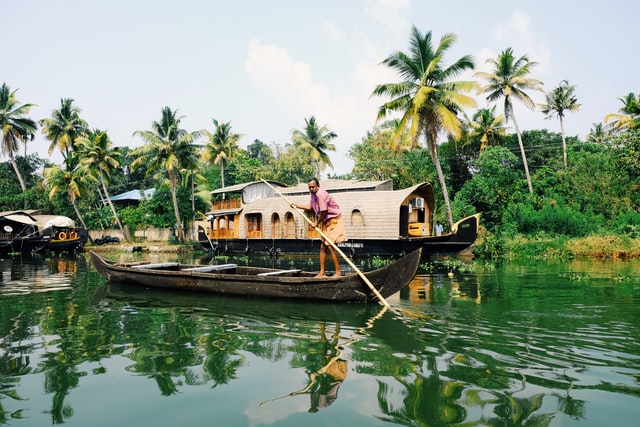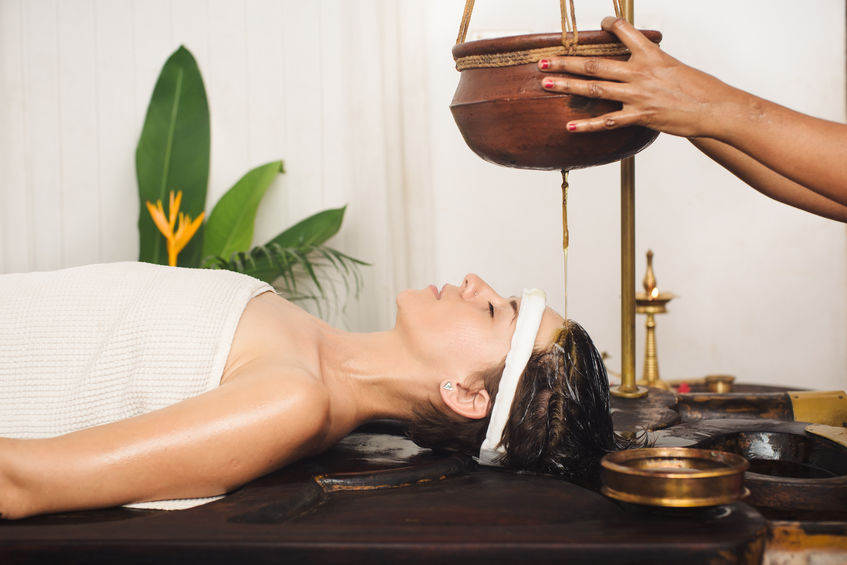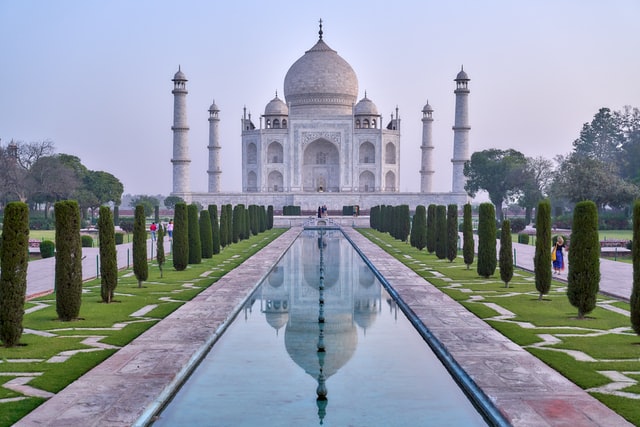|
Experiencing Ayurveda at its Source
Many people in the west who have come in contact with Ayurveda in a wellness hotel or spa resort are keen to know more about ayurveda in its primordial form. They want to experience ayurveda in a traditional health resort either in India or Sri Lanka. The range of offered packages are meanwhile quite comprehensive. The quality and the scale of the programmes vary largely from one location to the other.
The factors to be taken into account in order to find a good quality ayurveda health resort are the hygiene standards set at the local accomodation, the quality of professional medical attendance and of course the surrounding ambience in which the health resort is embedded.
The following article will try and illustrate the distinctions which a western health tourist might experience if he or she chooses an ayurveda health resort either in India or Sri Lanka.
Compared to Sri Lanka, India is a big country, if not a subcontinent with various climate and vegetation zones. Since the last 10 years Ayurveda health resorts have cropped up in various of these climate zones in India. In order to make the right choice for a western health tourist, these climate zones have to be reckoned with.
India as a travel destination for Ayurveda health treatment
Ayurveda, the traditional medical science of India, is deeply rooted with the soul of this ancient country. In order to experience ayurveda in its original form, it is really important to get an overall idea about the specific characteristics of the indian culture.
The rythm, the pulse beat or the speed of life is very much different in India than in Europe. The difference is even bigger if one experiences the rythm in the big indian mega-cities and the more rural or touristic areas. India is a country full of extremes and ist vibrations will not leave you indifferent. What is really striking is that these extremes coexist at proximate vicinity with each other. This makes it for the “first time visitor ” an unforgettable experience. Here a short description what you might encounter once you have landed, left the airport and entered one of the big cities:
Moving along the streets you might smell beautiful, tasty fragrances on one hand and suddenly be overwhelmed by repulsive, putrid odours on the other. Shabby and neglected children are sitting along with other beggers in the vicinity of modern supermarkets. Cows are standing in the middle of the road and the traffic driving elegantly around them. In the megacities there is no way to escape the massive crowd of people, an experience which is sheer overwhelming in the beginning.
Once having moved out of the megacitiy the rythm and beat calms down and you experience beautiful landscapes, rich flora and fauna and off and on a few people going to their agricultural fields or walking towards their villages. In the countryside everything is kept on a much more simple level, although the TV and the mobile telefone has also reached the remote rural areas. Yet one has the feeling that the lifestyle has hardly changed over the last centuries.
For a western traveller to experience and realise the great contrast between urban and rural life can become a great challenge in the beginning, especially when one realises that both these worlds exist simultaneously next to each other.
It is thus important not to look at India from a western perspective but to tune yourself in into this totaly different frequency of this ancient culture. Then India will be truly an enriching experience.
Ayurveda as the medical system of India
Ayurveda has its origin in India thousends of years ago. During the Moghul rule in India (15th – 19th century) the teachings of ayurveda were strongly suppressed. During the subsequent invasion of India by the British Empire, ayurveda as a form of medicine, was nearly estinguished from the country. It was only in the the hindu and buddhist monastries where this ancient medical system was preserved and practised. A lot of emphasis was layed in these monastries that ayurveda was practised in its authentic form and not get mixed with other (especially western) medical systems. As a result, ayurveda is still practised in its origianal form in contemporary India.
At present, ayurveda is taught in universities as a five year medical course. The basic sources of study are the thousend year old traditional scriptures. The most important scriptures to mention in this context are the Caraka Samhita and the Susruta Samhita. These scriptures are timeless and still up-to-date since the human anatomie and physiology has not changed over the last thousands of years.
On principle, ayurveda is an open medical system, which also lays emphasis on research work regarding contemporary disease patterns brought about by the hectic life of the 21st century.
In India, especially in rural regions, ayurvedic medicine is applied on a wide and large scale. The reason is that the ayurveda treatment and medicine are of much lower cost. Moreover the remedy from the suffered deseases is often better and lasts longer.
Characteristics of Ayurveda Treatment in India
One of the typical attributes of a traditional ayurveda resort is the simple style of furnishing and setting. The massage tables are made of wood. There is in general no soft cushioning on the table. So lying on it for more than an hour or so can be quite challenging for the western guests. In an indian ayurveda clinic or hospital, not much attention is paid to create a cosy ambience. The rooms are decorated in a simple and functional manner.
But you can be sure that the medical staff, be it the doctors, nurses or masseurs in such resorts or hospitals have a well-founded qualification and thus offer a high standard of traditional ayurvedic health treatment.
The massage techniques are quite energetic and of vigorous character. The massage treatments can thus also be at times quite painful. They have nothing in common with wellness treatments of the west where the guest is pampered and spoilt. In India, the land where ayurveda originated, the treatments are applied in the traditional form till the present day. When a special disease pattern is treated, you will get along with various detoxification treatments also a strict nutrition schedule alongside with a daily structured routine plan. The ayurvedic treatment is rounded up by giving the patient various herbal and mineral medicines which he schould take according to a daily plan.
The success of an ayurveda treatment depends essentially on the fact as to how a patient follows the entire treatment plan. In order to use ayurveda as a path of healing a lot of self- discipline is needed from the patient.
During the last fifteen to twenty years it has been shown in various case studies that an enduring and sustained ayurvedic treatment has a high probability of being successful in healing various chronical deseases, something which the western allopathic medicine cannot accomplish.
The Ayurvedic Medicine has just like the western medicine various specialisations. In order to get the appropriate treatment for a special disease, it is important to inform yourself a priory which ayurveda clinic or health resort is specialised on this field of treatment.
Suitable high quality Ayurveda Health Resorts in India
The ayurveda interested health tourist will find ayurveda health resorts in various parts of India. Each venue has its own specific character, depending on the landscape, climate, vegetation and of course the population distribution. You should feel comfortable and totally at ease during your stay at the chosen ayurveda health resort. The characteristic feature of the immediate environment of the resort plays an important role. If possible, choose a resort which is surrounded by unpolluted nature.
If you are suffering from a specific disease and want to get an ayurvedic medical treatment in India, then it is important to inform yourself whether the ayurvedic doctors of a specific health resort are specialised enough to treat your clinical picture or not.
The following lines describe the various regions in India where health tourists will find good quality ayurveda health resorts.
Kerala

Photo by kyran low on Unsplash, Kerala Backwaters
The stronghold for ayurveda health resorts in India for foreigners is located in Kerala. Since a couple of years even Indians are increasingly travelling to Kerala to get ayurveda treatment and recreation. Its endless long sandy beaches, the mild tropical climate and the backwaters make Kerala a unique place to experience the recreational value of ayurveda in India. In addition to that, Kerala has an extensive distribution of wildlife sanctuaries providing for ample forest and wildlife stock.
The rainy or better known as monsoon season takes place between June and October every year with abundant rainfall. During the rest of the year hardly any rain falls. The average temperature throughout the year varies around 27° C and the climate is characterised by high humidity.
The food served in Kerala is vegetarian with mild spices. The local population has a good command of the English language and the illiterate percentage is, compared to the rest of India, quite low.

Bild von WikiImages auf Pixabay, Kerala, Indien, Ottackal
Kerala stands for the traditional way of Ayurveda and its knowledge has been developed more and more over the centuries. The knowledge about Ayurveda has been given from generation to generation. There are only some left called 'Ashta-Vaidya-families' - families who master all 8 branches of Ayurveda. Most of the families in Kerala have pursued one of these branches and are now specialized in it. For example Pirichil and Kizichil have been developed further in Kerala. The wellknown Panchakarma Treatment is a classical treatment, which has been enhanced in Kerala, too.

Urheber : Dmytro Gilitukha ; 123RF_Dateinr : 51225614
Since 1998 the government of Kerala ensures uniform standards by ayurveda centers across the state. On the basis of quality and other standards, ayurveda centres are classified as Green Leaf or Olive Leaf. While the 'Olive Leaf' certification is given to those centres that fulfil a set of essential criteria laid down by the state, the 'Green Leaf' is awarded only to those that fulfil a set of optional criteria in addition. (More about this classification.)
Maharashtra

Bild von ParagKini auf Pixabay - Maharashtra Konkan Tempelanlage
Maharashtra is one of the largest states in India both in terms of population and area. 14 million people already live in Mumbai, formerly Bombay, the capital of Maharashtra. This city makes it not only one of the most important states economically, but also a major gateway for overseas tourism.
Maharashtra is characterized by three major regions - first the straight Konkan coastline with it's wonderful situated white and palm-shaded beaches, second the up to 1.400m rising West-Ghats with it's lush tropical vegetation and picturesque hill stations and third the Deccan-Plateau with 5 Nationalparks and reams of caves carved in stone with temples boast of stunning roch cut architecture.
The climate is moderate with variations in temperature ranging between 16°C and 35°C. Monsoon lashes parts of the state with good rainfall from July to September. The larger part of inner Maharashtra remains mostly dry. The comfortable climate and the close proximity to Mumbai have been good reason to accomodate various well known Ayurveda Resorts and Hospitals.
Karnataka
The state of Karnataka is situated north of Kerala and belongs also to South India. The coastal region is characterised by a humid alternating climate between rainy and dry seasons. Karnataka has a comparable climate to Kerala, with most of the rain falling during the summer monsoon. The rest of the year one can experience a very high humidity.
The mountain range called the Western Ghats belonging to Karnataka are one of the most rain-laden regions in India with an average rainfall of upto 5000 mm on average throughout the year. ´The largest part of the state is covered by the decann plateau. There we find the source of the three most important rivers of the region, Krishna, Kaveri and Tungabhadra.
From an economic point of view, Karnataka is one of the most developed and consequently one of the richest states in India. The capital of Karnataka, Bangalore (in India lately known as Bengaluru) is the „Silicon Valley“ of India. This rapidly expanding city is characterised by numerous green lawns and public spaces giving it the name „garden city“.
In spite of the economic development over the past decade, 55 % of the states territory is still being used agriculturally.
Goa
Goa lies in the middle of the west coast and is the smallest of the Indian states. Goa is best known for its white sandy beaches making it an interesting tourist attraction. Being a portugiese colony for several centuries, Goa is one of the regions in India which sets western standards. If as a western traveller you are uncertain, whether you will be able to handle the “cultural shock” of India, Goa provides a first level comfort zone to acclamatize yourself. In addition to the long sandy beaches, Goa also offers various natural lanscapes. In the Bhagwan Mahavir Nationalpark you can visit and see various wild animals living in their natural habitat.
All year round Goa offers a coastal and therefore moisty-hot climate. During monsoon, from June to beginning of September, heavy rains descent temporarily, especially in June temperatures rise up to 39°C - this can be very exhausting to the body. It is recommended to visit Goa from November till March with moderate temperatures from 25°C to 33°C during daytime and comfortable cool temperatures at nighttime. October and April might be good for visiting as well.
Himalaya Region
For lovers of mountain regions, India offers a couple of ayurveda resorts at the foots of the himalayas. The basic climatic conditions in the northern region of India are very much different to the southern coastal regions. The air is crisp, dry and clear. The temperatures fluctuate quite strongly, both during day and night as well as throughout the year. The peace and serenity in this region as well as the beautiful landscapes are incomparable. The presence of the high himalayan peaks and the deep valleys offer a good setting to bring back clarity and healing of the mind.
In addition to the regions described above, there are of course other regions in India, where you can experience ayurveda. Especially if you are travelling for the first time to India, it is advisable to book your journey wit the help of one of the various travel agencies, which have specialised themselves on Ayurveda. Some of these agencies have developed adequate questionnaires, which can be consulted, in order to find out your individual preferences regarding locations for ayurveda.
According to your health condition, your demands regarding accomodation, and your preferences concerning the climate and natural surroundings, you will find various options from which you will certainly find the right place for discovering ayurveda in its original homeground, India.
Comparison of Ayurveda Treatments in India and Sri Lanka
Ayurveda in India
- Traditional, authentic way of ayurvedic medicine
- Deep tissue treatments
- Predominantly simple and functional settings, but comfortable hotels as well
- Very well educated staff, including doctors as well as attendants
- Ayurvedic hospitals and ressorts in various regions and climate zones
Ayurveda in Sri Lanka
- Intermixture of ayurvedic tradition an regional health system
- Mostly soft treatment techniques
- Lovingly decorated, comfortable settings
- Good educated doctors; educational degree of attendants differs
- Great amount of “tourism-ayurveda”
- No visa needed for short term visits (up to 30 days)
How to choose the right destination?
Ayurvedic treatments in India fit for:
- Open minded and flexibel people concerning different cultures
- Selective treatments of diagnosed illnesses
- Low(er) needs for comfort (especially in clinics)
Ayurvedic treatments in Sri Lanka fit for:
- Insecure, thin-skinned people
- Wellness-holidays
- High needs for comfort
Titelbild: Photo by Julian Yu on Unsplash
|









.png)



